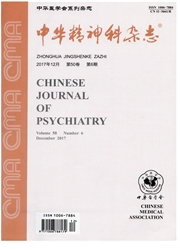

 中文摘要:
中文摘要:
目的探讨抑郁症和双相抑郁患者情绪图片任务下脑功能激活的特异性。方法采用任务态功能磁共振成像研究方法,对30例双相I型抑郁、30例抑郁症(majordepressivedisorder)及30名健康对照者进行负性和中性情绪图片任务态脑fMRI(functionalmagneticresonanceimaging,fMRI)扫描,最后纳入分析的双相I型抑郁症患者17例(双相I型组)、抑郁症18例(抑郁症组)及对照组21名(对照组)。采用SPM及REST软件对3组图像进行预处理及统计学分析,对单因素方差分析结果脑功能激活有差异的脑区进行post.hoc两两检验,并采用Pearson相关分析对HAMD17与差异脑区体素值进行相关分析。结果(1)与对照组比较:双相I型组在负性和中性情绪图片任务下,均表现为右侧海马旁回[负性图片MNI坐标(x、y、z):27、-21、-18,t=4.84;中性图片MNI坐标(x、y、z):21、-33、-12,t=5.33]激活降低(P〈0.05),未见激活增强的脑区;抑郁症组在负性情绪图片任务下,表现为右侧额中回『MNI坐标(x、y、Z):9、9、69,t=4.961激活增强(P〈0.05),未见激活降低的脑区;在中性情绪图片任务下,表现为双侧额中回[左侧额中回MNI坐标(x、y、z):-24、9、63,t=5.39;右侧额中回MNI坐标x、y、z):15、12、69,t=5.95]、右侧前扣带回[MNI坐标(x、y、z):9、12、42,t=4.91]、右侧额下回[MNI坐标(x、Y、z):48、21、-15,t=4.94]激活增强(P〈0.05),未见激活降低的脑区。(2)与抑郁症组比较:在负性情绪图片任务下,双相I型组未见激活有差异的脑区;在中性情绪图片任务下,双相I型组表现为左侧楔前叶[MNI坐标x、y、z):-3、-66、39,t=4.651激活降低(P〈0.05),未见激活增强的脑区。(3)Pearson相关分析显示,在负性和中性情绪图片任务中均未发现2个患者组各激活降低或增强脑区体?
 英文摘要:
英文摘要:
Objective To investigate the characteristics of brain function activity in patients with bipolar depressive disorder and major depressive disorder (MDD) facing affective pictures. Methods Thirty bipolar I depressive disorder patients, 30 MDD patients and 30 heahhy controls were included in the study. All subjects were scanned with 3.0T MRI scanner in negative and neutral affective pictures task state. After eliminating those taking medicines and head moving, and matching the factors such as gender, age and education level et al, there were 17 patients with bipolar I depressive disorder, 18 patients withMDD and 21 healthy controls in the final analysis. Using SPM and REST software to complete the image preprocessing and statistical analysis of the three groups and one-way analysis of variance (ANOVA) with least significant difference (LSD) post-hoc tests were used to compare different brain regions. Meanwhile, Pearson correlation analysis was performed to further assess the relationship between the clusters of these different regions and HAMDj7 score. Results Facing negative and neutral affective pictures tasks, subjects with bipolar I depressive disorder showed lower activation in right parahippocampus (negative affective pictures MNI (x, y, z): 27,-21,-18; t=4.84; neutral affective pictures MNI (x, y, z): 21,-33,-12; t=5.33) than the healthy controls (P〈0.05). There was no greater activation in subjects with bipolar I depressive disorder rather than the healthy controls. Facing negative affective pictures tasks, subjects with MDD showed greater activation in right middle frontal gyms(MNI (x, y, z): 9, 9, 69; t=4.96) than the healthy controls (P〈0.05).There was no lower activation in subjects with MDD rather than the healthy controls. Facing neutral affective pictures tasks, subjects with MDD showed greater activation in bilateral middle frontal gyms(left middle frontal gyrus MNI(x, y, z): -24, 9, 63; t=5.39; right middle frontal gyrus MNI(x, y, z):
 同期刊论文项目
同期刊论文项目
 同项目期刊论文
同项目期刊论文
 White matter integrity alterations in young healthy adults reporting childhood trauma: A diffusion t
White matter integrity alterations in young healthy adults reporting childhood trauma: A diffusion t Reduced Cingulate Gyrus Volume Associated with Enhanced Cortisol Awakening Response in Young Healthy
Reduced Cingulate Gyrus Volume Associated with Enhanced Cortisol Awakening Response in Young Healthy Elevated specific peripheral cytokines found in major depressive disorder with childhood trauma expo
Elevated specific peripheral cytokines found in major depressive disorder with childhood trauma expo Altered regional homogeneity in post-traumatic stress disorder: a restingstate functional magnetic r
Altered regional homogeneity in post-traumatic stress disorder: a restingstate functional magnetic r Elevated specific peripheral cytokines found in major depressive disorder patients with childhood tr
Elevated specific peripheral cytokines found in major depressive disorder patients with childhood tr Repetitive transcranial magnetic stimulation as an augmentative strategy for treatment-resistant dep
Repetitive transcranial magnetic stimulation as an augmentative strategy for treatment-resistant dep Grey matter volume abnormalities in patients with bipolar I depressive disorder and unipolar depress
Grey matter volume abnormalities in patients with bipolar I depressive disorder and unipolar depress Abnormalities in whole-brain functional connectivity observed in treatment-naive post-traumatic stre
Abnormalities in whole-brain functional connectivity observed in treatment-naive post-traumatic stre Abnormalities of cortical-limic-cerebellar white matter networks may contribute to treatment-resista
Abnormalities of cortical-limic-cerebellar white matter networks may contribute to treatment-resista Abnormalities in whole brain functional connectivity observed in treatment-naive post traumatic stre
Abnormalities in whole brain functional connectivity observed in treatment-naive post traumatic stre Posttraumatic stress disorder among female victims of sexual assault in China: prevalence and psycho
Posttraumatic stress disorder among female victims of sexual assault in China: prevalence and psycho A comparative study of theoretical graph models for characterizing structural networks of human brai
A comparative study of theoretical graph models for characterizing structural networks of human brai 期刊信息
期刊信息
